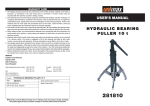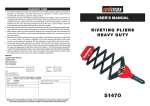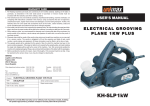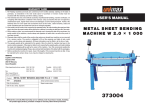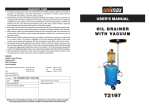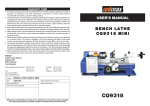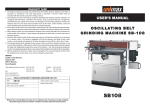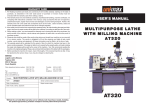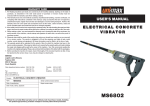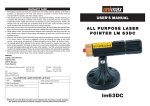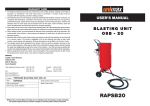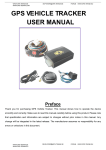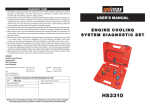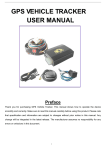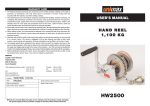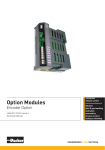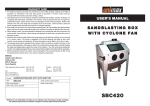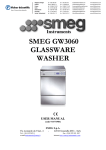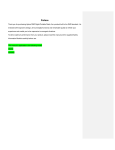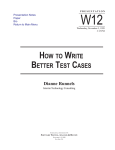Download HYDRAULIC BENDER PIPES 16 T
Transcript
??? CARD WARRANTY 1. KH Trading machines and tools are covered by 6/24 months warranty, starting on the date of purchase, as described in the Civil Code (proof of purchase or invoice receipt must be enclosed with the warranty card when making a claim). 2. This warranty does not cover defects caused by unprofessional handling, machine overloads, not complying with instructions contained in this manual, using accessories that are not approved, unauthorized repair, regular wear and tear and damages occurred during transport. Further, this warranty does not cover parts and accessories such as the motor, carbon brushes, seals and hot-air operated parts and parts that need to be changed regularly. 3. If the repair is to be found as not covered by the warranty policy, all costs including the repair and shipping to and from the repair centre will be paid by the customer, according to valid price list. See www. 4. When making a claim, you must present the warranty card, showing the date of the purchase, the serial number of the machine, vendor stamp and signature of sales clerk, as well as the proof of purchase receipt. 5. Warranty claim shall be made at the vendor shop where you bought your machine or you may mail it to a service centre. The vendor is obligated to fill out the warranty card (date of sale, serial number, vendor stamp and signature). All these information must be filled in at the time of sale. 6. The warranty period will be extended for the period of time for which the machine has been in the service centre possession. If the repair or defect is not covered by the warranty policy, all costs including the repair and shipping will be paid by the owner of the machine / tool. We recommend sending the machine in its original packaging. Please, also enclose brief description of the defect with the packaging. 7. Before sending the machine for repair, clean it thoroughly. If the received machine is dirty, it may be rejected by the service shop or you may be charged a cleaning fee. USER'S MANUAL HYDRAULIC BENDER PIPES 16 T SERVICE Logistic centre Klecany Topolová 483 250 67 Klecany Czech Republic Claim department phone number: 266 190 156 266 190 111 Fax: 260 190 100 http://www.KHnet.cz Email: [email protected] Product: Type: T-mobile: 603 414 975 O2: 601 218 255 Vodafone: 608 227 255 HYDRAULIC PIPE BENDER 16 T Serial number (product series): LJY16 Date of manufacture: Repair centre notes: Date of sale, stamp, signature: LJY16 Without the correctly filled warranty card or without proof of purchase receipt, including the product type (invoice, purchase receipt) no warranty claim will be processed. Dear customer. Thank you for purchasing equipment from KH Trading, s.r.o. Our company is ready to offer you our services - before, during and after you buy our product. If you have any question, comment or idea, please contact our business centre. We will do our best to address your comment or question in timely matter. Before first use, please read this manual carefully. It is your responsibility to study all instructions, necessary for safe use and operation and to understand all risks that may be involved during the use of power machines. WARNING! Do not try to use this machine before reading this entire manual and before you know how to handle it. Keep this manual for future reference. Pay special attention to safety instructions. Not complying with safety rules may cause injury to the operating person or to people standing by or it may cause damage to the machine or to the work piece. Pay special attention to safety notes and safety labels on the machine. Never remove or damage them. Please, write information such as the invoice number and the number of the sale receipt here in this box. DESCRIPTION Compact pipe bender with pressure 16 t. The bender is designed for bending steel pipes without joints, with a round cross-section in the vertical position. It is possible to bend long pipes in the horizontal position. Adjustable upper cylinder enables bending of up to 180°. Not to be used for pipes that do not have a round cross-section, pipes with joints or cast-iron. 8 pcs of cast-iron beds are components off the delivery, for bending pipes with a diameter of 1/2" (15 mm); 3/4" (20 mm); 1" (25 mm); 1 1/4" (32 mm); 1 1/2" (40 mm); 2" (50 mm); 2 1/2" (65 mm); 3" (80 mm); TECHNICAL SPECIFICATIONS Pressure . . . . . . . . . . . . . . . . . . . . . . . . . . . . . . . . . . . . . . . . . . . . . . . . . . . . . . . . . . . . . . . . . .12 t Max. bending angle . . . . . . . . . . . . . . . . . . . . . . . . . . . . . . . . . . . . . . . . . . . . . . . . . . . . . . . . .180° Cast-iron beds for bending 1/2" . . . . . . . . . . . . . . . . . . . . . . . . . . . . . . . . . . . . . . . . . . . . . . . . . . . . . . . . . . . . . . . . . . .15 mm 3/4" . . . . . . . . . . . . . . . . . . . . . . . . . . . . . . . . . . . . . . . . . . . . . . . . . . . . . . . . . . . . . . . . . . .20 mm 1" . . . . . . . . . . . . . . . . . . . . . . . . . . . . . . . . . . . . . . . . . . . . . . . . . . . . . . . . . . . . . . . . . . . . .25 mm 1 1/4" . . . . . . . . . . . . . . . . . . . . . . . . . . . . . . . . . . . . . . . . . . . . . . . . . . . . . . . . . . . . . . . . .32 mm 1 1/2" . . . . . . . . . . . . . . . . . . . . . . . . . . . . . . . . . . . . . . . . . . . . . . . . . . . . . . . . . . . . . . . . .40 mm 2" . . . . . . . . . . . . . . . . . . . . . . . . . . . . . . . . . . . . . . . . . . . . . . . . . . . . . . . . . . . . . . . . . . . . .50 mm 2 1/2" . . . . . . . . . . . . . . . . . . . . . . . . . . . . . . . . . . . . . . . . . . . . . . . . . . . . . . . . . . . . . . . . .65 mm 3" . . . . . . . . . . . . . . . . . . . . . . . . . . . . . . . . . . . . . . . . . . . . . . . . . . . . . . . . . . . . . . . . . . . . .80 mm Packaging dimensions I . . . . . . . . . . . . . . . . . . . . . . . . . . . . . . . . . . . . . . . . . . . . . . . . . . . . . . . . . . .660 × 630 × 210 mm II . . . . . . . . . . . . . . . . . . . . . . . . . . . . . . . . . . . . . . . . . . . . . . . . . . . . . . . . . . .440 × 385 × 140 mm Gross weight . . . . . . . . . . . . . . . . . . . . . . . . . . . . . . . . . . . . . . . . . . . . . . . . . . . . . . . . . . . . . .70 kg The accuracy of instructions, graphs and information contained herein, depends on the printing date. Due to continuous product improvement, the manufacturer reserves the right to change technical parameters of the product, without prior customer notification. 2 REPAIR AND MAINTENANCE REPORT Report and maintenance report: DATE REPAIR AND MAINTENANCE REPORT SERVICE SHOP ??? SAFETY PRECAUTIONS DETAILED ??? DRAWING • This machine may be used by a qualified person, 18 years or older who has been trained in work and environmental safety procedures. • Any person using this equipment must possess a medical certificate demonstrating his eligibility to operate this equipment. We recommend placing warning labels on conspicuous places around your workplace. • "Prevent most common injuries" - BENDER Safety symbols and self-adhesive safety stickers: Use a safety helmet Read manual before use Use protective gloves Use eye protection Use protective foot gear Danger of limb injuries Place the self-adhesive stickers on an appropriate and visible spots on your machine. Symbols used in this manual Warning! This symbol informs you about the risk of personal injury or damage to the machine or materials. Risk of being caught by moving machine parts! Beware of moving machine parts. Loose clothing or body parts may get caught by moving machine parts. PART LIST Position 1 2 3 4 5 6 7 8 9 10 11 12 13 14 15 16 17 10 Name MATRIX 1/2" MATRIX 3/4" MATRIX 1/" MATRIX 1 1/4" MATRIX 1 1/2" MATRIX 2/" MATRIX 2 1/2" MATRIX 3/" FRAME HYDRAULIC CYLINDER 16T Handle Screw SPRING BOARD Spring Pulley Safety pin Stud Pc 1 1 1 1 1 1 1 1 1 1 1 2 1 2 2 4 2 Warning! Danger of damage. Note: Additional information. Use personal protective gear. General instructions • Plastic bags and packaging materials pose danger for small children and animals. • Make sure you know your machine and you are familiar with its operating procedure. Know the hazards if not used correctly. • Person using this machine must be properly trained and must know how to safely operate this equipment. He must be also aware of the hazards and risks that may occur if not used correctly. • Pay special attention to safety notes and safety labels. Do not remove or damage them. In case of the labels are damaged or become illegible, contact the supplier. 3 • Keep your working place clean. Disorganized and dirty working area may cause accidents. • Never work in narrow or poorly lit rooms. Make sure that the floor is stable and that your work may be done comfortably. Always keep stable posture. • Stay focused and use all your senses. Pay attention to the working procedure. Do not continue to work if you cannot pay full attention. • Maintain your machines clean. • Handles must be kept free of grease and dirt. • Make sure no children, unauthorized persons or animals have access to your workshop. • Never put your hands or legs inside the working area. • Never leave your machine unattended during operation. • Use only for purposes for which it has been designed. • Use personal protective gear such as safety goggles, ear protection, respirator, safe working shoes etc. • Do not overreach and use both hands. • Never work under the influence of alcohol or other drugs. • Do not use the machine if you feel dizzy or weak. • Any modifications or improvements to the machine are strictly prohibited. DO NOT USE if you discover bent part, crack or other damage. • Never perform any maintenance during operation. • If you see any unusual sign or hear any strange sound, stop the machine and stop working immediately. • Do not forget to remove all wrenches and screwdrivers from the machine after use. • Before use, make sure all screws are tightened securely. • Perform maintenance regularly. Before use, make sure the machine is in good working conditions and without any damage. • Use only original spare parts for repairs. • Using non-original spare parts or other parts not approved by the manufacturer may cause injury to the operating personnel. • Use this machine only for work that it is capable of handling. Do not overload your machine or accessories. Do not attempt to use the machine with insufficient power to perform heavy duty work. • Do not overload your machine. Measure the work load in such way, so it could be done with comfortable speed. The Warranty does not apply to damages incurred by overload. • Do not expose to extremely high temperature or direct sunlight. • This machine is not design for use in humid environments or under water. • If you are not using your machine, store it in a dry and safe place, out of reach of children. • Before turning your machine on, make sure that all safety elements are working properly and effectively. Make sure all movable parts are in good condition. • Before use make sure that no part is cracked or stuck. Make sure all parts are attached and assembled as designed. Beware of all other conditions that may have a negative effect on the proper functioning of your machine. • If not stated otherwise in this manual, all damaged parts must be repaired or changed. Fine mechanics • Never use a clamp to hold your machine. • Protect you machine from impact and fall. • Release the piston into the lower position and check the level, if necessary, add oil once again to the lower edge. • Close the opening with the rubber plug. NOTE Wipe the spilt oil with a cloth. It is necessary to dispose of the oil and dirtied cloth as hazardous waste. Lubrication Lubricate working surfaces of the studs with appropriate grease regularly. Conserve the springs against corrosion with an appropriate solution. DISPOSAL • Used hydraulic fluids must be disposed off in accordance with the Law of waste disposal management. When the operational life of your machine is over, dispose off it in accordance with valid rules and regulations. Your product is made of metal and plastic parts that may be recycled when separated. 1. Disassemble all parts. 2. Separate all parts according to the material they are made of (e.g. metals, rubber, plastics, etc.). Take the separated parts to the recycling facility near you for further processing. Information about the locations of recycling centres may be found at your local City office or throughout an Internet search. CAUTION If the machine breaks down, send it back to the vendor for quick repair. Please, enclose brief description of the defect. That makes repair easier. If the machine is still covered by warranty, enclose the warranty card and proof of purchase receipt. After the warranty period expires, we repair your machine for a special price. To prevent possible damages during shipping, packed the machine carefully or use the original packaging material. We are not liable for shipping damages due to incorrect packaging of your machine. If making a claim at the shipping company the level and method of packaging plays a major role during claim evaluation process. Note: Pictures and contents in this manual may slightly differ from the actual product or accessories. It is due to continuous improvement of our products. Such small differences have no effect on the product functionality. Assembly • Do not use the machine unless completely assembled. 4 9 MAINTENANCE • Keep your machine clean. Dirt from machines may enter the inner machine mechanism and cause damages to the machine. • Do not use aggressive cleaning solution or paint thinners to clean the machine. • Clean plastic parts with soft cloth dipped in soapy water. • Clean and lubricate metal surfaces with a cloth dipped in paraffin oil. • If you are not using your machine, conserve it with grease and store it in dry place to prevent corrosion. Detailed description of the use of this device is not included in this manual, because the manufacturer / distributor assumes that the user is experienced in similar type of work. Also according to the applicable law, this device is considered as a commonly sold and used tool. If the user is unfamiliar with the use of this device, we recommend finding out more information about using this device at the Department of work safety. Hydraulic equipment • If the bender is not being used, store the pumping unit with the open release tap, in order to prevent the spring from becoming tired. Tired springs result in problems with the pistons ability to return to the initial position. Hydraulic fluid refill: • Before refilling, checking or changing the oil, always wipe the surrounding surface of the input opening thoroughly with a cloth, which is found on the side of the cylinder and it is covered by a rubber plug. That way you prevent dirt from entering the system and possible breakdown or quick wear out. • Check the level of oil by placing the bender unit in the upright position. • Open the valve and release the piston as low as possible • Remove the rubber plug on the side of the working cylinder. • The oil level should be in line with the lower edge of the opening. • If necessary, refill with hydraulic oil to the lower edge of this opening. • The pump has been filled with a high quality hydraulic fluid at the factory. After long-term use, the oil should be changed, in order to ensure longer life of the facility and to clean out the abrasion. Oil change • Before changing the oil, always wipe the surrounding surface of the input opening thoroughly with a cloth, which is found on the side of the cylinder and it is covered by a rubber plug. That way you prevent dirt from entering the system and possible breakdown or quick wear out. • Open the valve and release the piston as low as possible • Remove the rubber plug on the side of the working cylinder. • Place the bender on its side and pour out the used oil. Prevent the oil from spilling. • Place the bender back into the upright position and pour new oil in up to the lower edge of the opening for filling. • Close the valve and pump out the piston into the upper position. 8 Hydraulic equipment • Small escape trace of hydraulic fluid form the hydraulic pump and from other hydraulic equipment is a standard character and it is not considered a defect. If there is a shortage of hydraulic fluid it must be refilled regularly. • Before uncoupling compressed air piping or hose, turn off the air pressure supply. Wait until the pressure equalizes. • Before starting your work, inspect all couplings and piping for leakage. If leak is found repair it immediately. • Never put more load/stress on the hydraulic cylinder than the maximum allowed. Do not try to extend the piston bar using excessive force. It may come out of the cylinder completely. • If the quick couplings are disconnected, place safety plugs in the opened inlets to prevent dirt from entering the system. • Keep your machines far away from heat sources and fire to prevent damages to your machines. • Hydraulic fluid spill on floor creates danger of slipping and risk of personal injuries. If you discover spill have it cleaned immediately. Use appropriate cleaning wool or absorbing substance. In accordance with the rules of waste law management, absorbing substances or wool must be properly stored in enclosed metal container and delivered to authorized waste collection centre. • Do not mix different hydraulic fluids together (e.g. from different manufactures). • Follow the hydraulic fluids change periods. • Make sure that you are using clean hydraulic fluids. Dirt in the fluids significantly lowers the lifespan of the fluid and may cause irreversible damages to your machine. • Use protective covers and blind flanges to prevent impurities from entering into the machine. Bending • Firmly affix the machine to a flat and solid floor or work table, which will be stable enough upon the effect of bending power. • When working, the bent material can eject unwontedly or crack • Upon overload, any of the parts may crack and be ejected. • Upon sudden release of energy, the bender may also suddenly shift. • Do not extend the lever of the hydraulic pump in any manner with adapters. • Before bending, mark the place of bending and duly attach the material by tightening the self-locking pliers. • Do not use the facility for pipes, which do not correspond with the technical parameters of the machine. Do not use on hardened or reinforced materials and on cast-iron. • The machine is only designed for bending pipes without joints and with a round cross-section. • Do not touch the gear-box mechanism while working to prevent possible injury. • Do not put your hands into the bending space. • When working steel pipes, use gloves to prevent cuts and other similar injuries. Power machines • Before initiating maintenance work with the use of hydraulic machines, gradually decrease the work pressure to atmospheric. • Should the machine contain compressed springs, always insure its gradual and safe release with the aid of an appropriate preparation. 5 ASSEMBLY • Before throwing the packaging material out, make sure no part is left inside. If so, take it out and install it. Use the part listing for check-up and the installation drawing for guidance. Positioning the bender • The most appropriate place for positioning the bender is by a wall, which creates an angle into the space. • An unsuitable place is by a wall or in the corner. • Select the place with consideration to the length of the processed pipes. Working position • The bender is designed for bending pipes in the upright position. • It is also possible to use it in a tilted position, but this can lead to a dependence on keeping the oil full to partial aeration and resulting decrease in effectiveness in relation to the angle of the bender. OPERATION Use protective goggles, work gloves, helmet, foot gear, when working. Suitable pipes for processing on the bender • Steel pipes without joints and with a round cross-section. • It is necessary to test the bending of any other material. Do not use • Steel pipes with joints • Steel pipes that do not have a round cross-section • Cast-iron pipes. Selecting the bender adapter • Select the adapter according to the pipe's diameter, the required diameter, wall thickness and type of material. The adapter is also determined by the radius of bending. Selecting the length of bent pipes • The pipe must be long enough to leave a sufficient overlap during bending, which prevents the end of the pipe from sliding off the guide pulley. • Always select a sufficient enough overlap with consideration to bending and other use. Attaching the guide pulleys • Always attach the pulleys in the body of the bender symmetrically according to the selected adapter. The bigger the adapter is, the great the distance must be between the pulleys. • The stud must always be covered completely in both openings in the body of the bender and secured with a safety-pin on the other side, which prevents the stud from coming out during bending. 6 Work with an unsecured stud is prohibited. Never use just the studs for bending pipes, always use it with the pulley. Procedure for bending pipes • Attach the adapter of the respective bent pipe to the hydraulic piston. • Insert the bent pipe into the adapter. • Insert the pulleys according to the aforementioned procedure into the respective slots in the bender's body. • Secure the pulley studs with safety pins. • Secure the position of the pipes on both ends with the help of self-locking clamps, to make sure their position is secured against slipping out during the process of bending and to prevent injury caused by ejected material. NOTE Prior to each operation, it is necessary to test the bending result on material of the same specifications and to count with a highly larger consumption. In case of series, it is possible to mark the bending site with guide lines and hence increase the speed of work and decrease the waste. When bending, the influence of pressure can shift the marked guide lines. Verify the correct use of various diameters of adapters for optimal selection for the required angle and radius. • Shut the valve on the lower side of the cylinder body with the help of the supplied lever. • Move upwards and downwards with the hydraulic pump lever while holding the pipe in the selected position for bending. • Count with a memory effect of material, when the material will spring out after discharge. To eliminate this effect it is possible to bend the pipe more than necessary. It is necessary to test this, because it depends on the material and size of bending. Another possibility is to leave the pipe in the bender for a while. CAUTION It is prohibited to watch the course of bending pipes from above and from both narrow sides. • To remove pipes, slowly release the valve on the lower side of the cylinder body and the spring returns the piston into the lower position. 7






